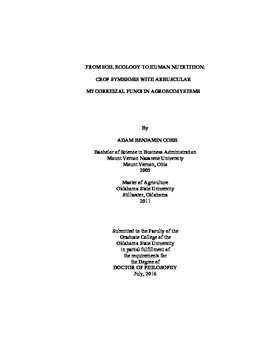| dc.description.abstract | The Green Revolution helped us reduce global poverty, hunger, and malnutrition over the past 30 years. My research is part of an emerging Brown Revolution that is unlocking the power of living soil to sustainability provide human needs. We are losing soil more quickly than it is being replenished - worldwide, an area of farmland the size of half an Oklahoma erodes away every year; however, arbuscular mycorrhizal (AM) fungi are microorganisms that can stabilize and enhance soil, while benefitting most of our crops with increased water and nutrients. A teacup of healthy soil contains enough AM fungi to stretch across 30 football fields from end to end, but some agricultural practices reduce the abundance of AM fungi on farms. These practices degrade soil stability and fertility over time, resulting in a waste of water, a waste of fertilizers, and environmental damage. My research seeks to harness the benefits of AM fungi for sustainable food production and nutrition. We focused on sorghum and cowpea, because they are important in many developing countries, but their efficiency and droughttolerance also make them ideal for places like Oklahoma. In the greenhouse and field, we assessed differences in plant response to AM fungi to discover which crop genotypes are the most effective partners. Then we examined how that partnership affected agricultural efficiency and seed (grain) nutritional contents, such as protein, zinc, and iron. We also assessed the impact of alternative fertility amendments (biochar, worm compost, reduced commercial fertilizers) and farm management practices (intercropping) on AM abundance, crop yield, and nutrition. More AM responsive genotypes and alternative amendments were shown to increase yield and/or key nutritional contents. Nearly 1 out of every 3 people on this planet are malnourished, and they often need more dietary protein, zinc, and iron; therefore, our results indicate that AM fungi improve soil health and human health as well. Crop genetics, alternative soil amendments, and farm management can enhance the benefits of AM fungi, and we can utilize them to help us regenerate our soils and nourish our growing population. | |
